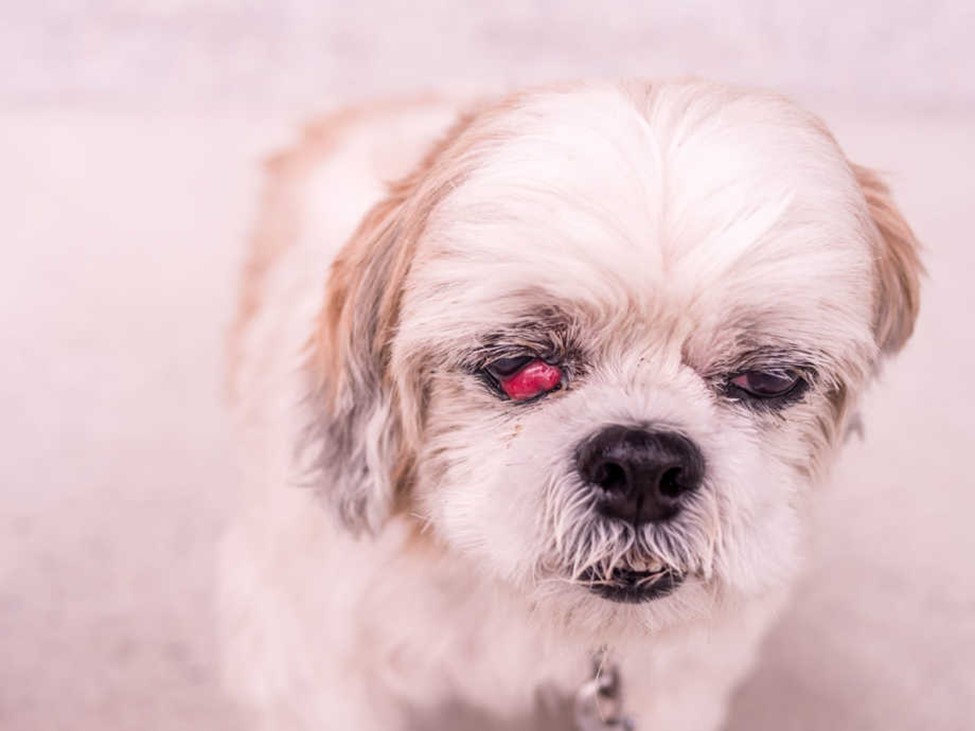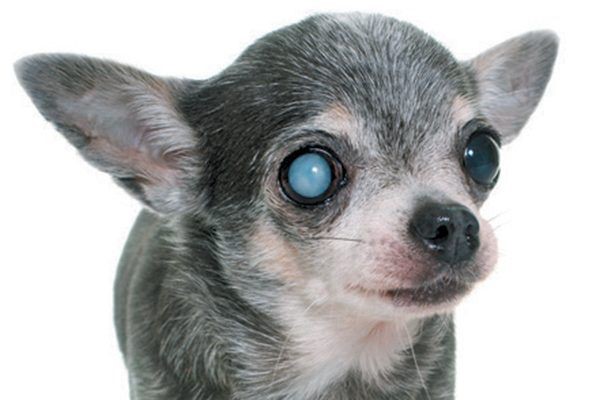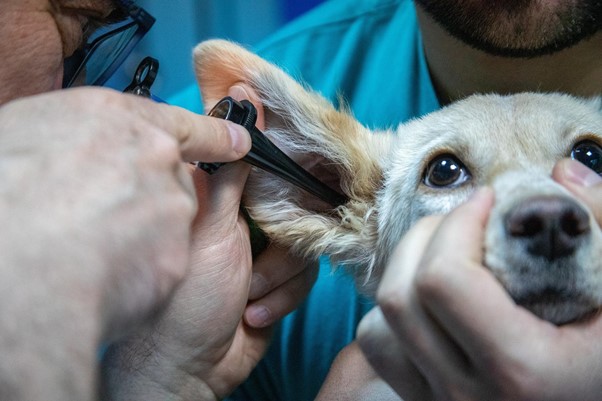Eye Disorders in Dogs
- Last updated on April 6, 2023
- By: Caroline Stowe
Dog eyes are delicate organs, so they are vulnerable to various diseases and disorders.
Common signs of eye problems in dogs include redness, swelling, discharge, squinting, and tearing. Dogs can also suffer from a variety of eye conditions such as dry eye (Keratoconjunctivitis Sicca), glaucoma, cataracts, corneal ulcers, and uveitis.
These conditions can be caused by infection or trauma, or may be genetic. It is important to seek veterinary care immediately if you notice any changes in your dog’s eyes, as some conditions can cause permanent damage and even blindness if left untreated.
Common Dog’s Eye Disorders
Corneal ulcers
Corneal ulcers in dogs, also known as ulcerative keratitis, are painful sores on the surface of the cornea. They occur when the thin outer layer of tissue is damaged by infection or trauma and can result in severe pain and vision impairment.
Corneal ulcers can be caused by bacterial or fungal infections, foreign bodies, or trauma. Symptoms of corneal ulcers may include squinting, excessive tearing, redness, pain, discharge from the eye, and an enlargement of the third eyelid.
Treatment typically includes antibiotic ophthalmic drops to fight infection and corticosteroid ointment to reduce inflammation. In more severe cases, surgery may be necessary.
It is important to consult your veterinarian as soon as possible if you notice any changes in your dog’s eyes. With prompt treatment, most dogs will make a full recovery.
If your dog has been diagnosed with corneal ulcers, it is important to follow the instructions provided by your veterinarian and monitor your dog’s eye health closely. Make sure to keep all follow-up appointments and administer any prescribed treatments as directed.
It is also important to take steps to prevent further trauma or infection, such as avoiding rough play, keeping the area around your dog’s eyes clean, and not allowing your dog to rub their eyes. With proper care and monitoring, you can help ensure your dog makes a full recovery.
Remember, if you notice any changes in your dog’s eyes, it is important to seek veterinary attention right away. Early treatment can help prevent vision loss or even blindness. If you have any concerns about your dog’s eye health, always contact your veterinarian for advice and appropriate treatments.
Glaucoma
Glaucoma is a condition in which the pressure inside the eye becomes too high, leading to pain and eventual vision loss if untreated. The most common form of glaucoma in dogs is primary glaucoma, which is an inherited condition. Secondary glaucoma can be caused by inflammation, trauma, or tumors of the eye.
Signs of glaucoma include redness and swelling, eye pain, cloudiness in the eyes, and vision loss.

Treatment for glaucoma typically involves medications to reduce eye pressure, as well as surgery in some cases.
Cataracts
Cataracts in dogs are caused by cloudiness of the lens of the eye, leading to vision loss. Cataracts may be present at birth or they can form later in life due to diabetes, injury, infection, or other causes.
Early treatment is important as cataracts can cause permanent blindness if left untreated. Treatment options for cataracts include medications and surgical removal of the cloudy lens.
It is important to take your dog to the vet as soon as you notice any changes in its eyes, as many eye conditions can cause permanent damage and vision loss if left untreated.
Dry Eye Syndrome
Dry eye syndrome, also called Keratoconjunctivitis Sicca (KCS), is an eye disorder in which the tear glands produce an inadequate amount of tears, leading to chronic dryness and irritation of the eyes.
This can lead to redness, swelling, pain, discharge, and cloudy vision if left untreated.
Treatment for dry eye involves medicated drops or ointments to help lubricate the eyes, as well as medications to reduce inflammation and infection. Surgery may also be recommended in some cases.
Causes of dry eyes in dogs can vary, but typically include trauma or injury to the eye, eye infections, certain medications, autoimmune diseases such as rheumatoid arthritis or Sjogren’s Syndrome, or congenital defects.
Ectropion
This can cause the eye to become irritated and red due to exposure of the conjunctiva, a thin membrane covering the inner surface of the eyelid. Ectropion can be caused by genetics or trauma, and can also occur as a result of facial nerve paralysis.

Treatment for ectropion typically involves surgery to reposition the eyelid and provide support to keep it in place. In some cases, additional treatments such as antibiotics or anti-inflammatory medications may also be needed to help reduce irritation and inflammation of the eye.
Early detection and treatment of ectropion can help prevent long-term eye damage and vision loss. It is important to seek veterinary care if you notice any changes in your dog’s eyes, as some conditions can cause permanent damage and even blindness if left untreated.
With the right treatment, most dogs can maintain good eye health and vision throughout their life.
Cherry Eye
Cherry Eye in dogs is a type of prolapse in which the third eyelid, or nictitating membrane, becomes swollen and protrudes from the corner of the eye. This condition can be caused by allergies, injury, or genetics.
Treatment for cherry eye typically involves surgery to reposition the eyelid back into place. In some cases, antibiotic ointment or anti-inflammatory medications may also be prescribed.
Conjunctivitis
Conjunctivitis in dogs is an inflammation of the eye, typically caused by allergies, foreign objects, or viruses. Symptoms may include redness and swelling of the eye, pain, and discharge from the eye, squinting, and tearing.
Treatment for conjunctivitis typically involves medicated eye drops or ointments to reduce inflammation and relieve symptoms. In some cases, antibiotics may also be prescribed.
Allergic Conjunctivitis
Allergic Conjunctivitis in dogs is conjunctivitis caused by an allergic reaction, typically to pollens, dust mites, or other allergens.
Symptoms can include redness and swelling of the eyes, excessive tears and mucus, squinting, and excessive blinking.

Treatment may involve anti-allergy medications such as corticosteroids or antihistamines, as well as medicated drops or ointments to reduce inflammation.
It is important to visit your veterinarian if you notice any changes in your pet’s eyes, so they can determine the cause of the condition and provide appropriate treatment.
Uveitis
Uveitis is an inflammation of the uvea, which is the middle layer of the eye. It can be caused by viral or bacterial infections, trauma, autoimmune diseases such as rheumatoid arthritis or Sjogren’s Syndrome, foreign bodies in the eye, or certain medications.
Symptoms may include redness, swelling, pain, and discharge from the eye, squinting, and vision loss.
Treatment for uveitis typically involves topical or oral anti-inflammatory medications to reduce inflammation and help restore vision. In some cases, antibiotics may also be prescribed to help treat any underlying infection.
It is important to closely monitor the condition and make sure your pet receives follow-up care as recommended by its veterinarian.
Blindness
Blindness in Dogs can be caused by various conditions, such as cataracts, glaucoma, progressive retinal atrophy (PRA), and uveitis.
Treatment for these conditions varies depending on the cause and severity of the condition. In some cases, surgery may be necessary to remove cataracts or to help relieve pressure in the eye caused by glaucoma.
Medications may also be prescribed to help reduce inflammation and control pain in some cases of uveitis or PRA.
Collie Eye Anomaly (CEA)
Collie eye anomaly (CEA) in dogs is a genetic condition that affects the eyes and can cause vision loss. This disorder is inherited, meaning it is passed down from parent to offspring.
Symptoms may include thinning of the retinal layers, detachment of the retina, or abnormalities in the shape of the eye.
Treatment for collie eye anomaly typically involves regular monitoring by an ophthalmologist to detect any changes or progression of the condition.
Unfortunately, there is no cure for this disorder, and vision loss may occur over time.
Sudden Acquired Retinal Degeneration Syndrome (SARDS)
Sudden acquired retinal degeneration syndrome in dogs (SARDS) is an uncommon condition that typically affects older dogs. This disorder causes sudden and progressive deterioration of the retina, resulting in vision loss.
SARDS is not fully understood by veterinarians or researchers, however, it is believed to be caused by an autoimmune response in which the body’s own immune system attacks the cells of the retina.

Treatment for SARDS typically involves eye drops to reduce inflammation and help control the progression of the disease. It is important to seek veterinary care as soon as possible if you suspect your pet may have SARDS, so they can receive appropriate treatment.
With early diagnosis and proper management, most dogs affected with SARDS can maintain good vision throughout their life.
Eye Medications
Eye medications for dogs can help reduce inflammation, control pain and discomfort, and restore vision. Topical medications, such as eye drops or ointments, are commonly used to treat common conditions such as uveitis, glaucoma, cataracts, PRA, CEA, and SARDS. Oral medications may also be prescribed in some cases.
Eye drops or ointments should be administered carefully, following the instructions given by your veterinarian. Before administering any medication to your pet, it is important to make sure their eyes are clean and free of debris.
How to use Eye Drops or Ointments
Hold the dropper near your pet’s eye, but not so close that the eye can feel the dropper touching it. Then gently pull down the lower eyelid and squeeze the prescribed amount of medication onto the eye.
Release the eyelid, and allow your pet to blink in order to spread the medication over their eye. Finally, wipe away any excess medicine with a clean tissue or cloth.
Remember to only use medications that have been prescribed by your veterinarian for your pet and never give your pet any medications intended for humans.
Check the video below to learn how to apply ointment to your dog’s eyes.
Conclusion
It is important to follow your veterinarian’s instructions carefully when using any type of eye medication. Make sure to monitor your pet closely for any signs of side effects and contact your veterinarian right away if you notice any changes in their condition.
With the right treatment plan, most dogs can maintain good vision and healthy eyes throughout their life. With proper care and regular eye exams, most dogs can maintain good eye health and vision throughout their life.
-
Author: Caroline Stowe
- Updated on April 6, 2023
Disclaimer: This article doesn’t intend to replace professional veterinary advice, nor should it be used as a substitute for veterinary services, diagnosis, or treatment. The content on this website, including information and opinions expressed herein, are intended for general informational purposes only. In case you have concerns or questions regarding your dog’s health and diet requirements, please consult your veterinarian before doing anything that might affect it.
DogPetGuide.com and the writer are not responsible or liable for any damage, liability, costs, or claims arising from any possible consequences of the reader’s action after reading this article.




